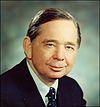
Texas's 3rd congressional district of the United States House of Representatives is in the suburban areas north and northeast of Dallas. It encompasses much of Collin County, including McKinney and Allen, as well as parts of Plano, Frisco, and Prosper. Additionally, the district includes all but the southern portion of Hunt County. The district is also home to a public four-year university, Texas A&M University-Commerce, as well as Collin College.

Texas's 13th congressional district is a congressional district in the U.S. state of Texas that includes most of the Texas Panhandle, parts of Texoma and northwestern parts of North Texas. The principal cities in the district are Amarillo, Gainesville and Wichita Falls. It winds across the Panhandle into the South Plains, then runs east across the Red River Valley. Covering over 40,000 square miles (100,000 km2), it is the 19th-largest district by area in the nation, the 14th-largest that does not cover an entire state, as well as the second-largest in Texas behind the 23rd congressional district. It covers more land mass than thirteen entire states. After the 2020 census was completed, the 13th district was heavily redrawn to incorporate Denton, an increasingly Democratic-leaning suburb of the Dallas-Fort Worth metroplex which had previously anchored the 26th district. With a Cook Partisan Voting Index rating of R+26, it is one of the most Republican districts in Texas.

Texas's 19th congressional district of the United States House of Representatives includes the upper midwestern portion of the state of Texas. The district includes portions of the State from Lubbock to Abilene. The current Representative from the 19th district is Republican Jodey Arrington. With a Cook Partisan Voting Index rating of R+26, it is one of the most Republican districts in Texas.
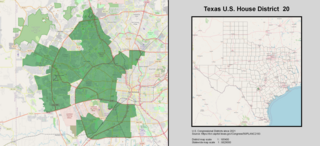
Texas's 20th congressional district of the United States House of Representatives includes the western half of San Antonio and Bexar County in Texas. The district is heavily Latino/Hispanic, as is the surrounding area. Charlie Gonzalez, who represented the district from 1999 to 2013 after succeeding his father, Henry B. González, did not seek re-election in the 2012 United States House of Representatives elections. State representative Joaquin Castro, the Democratic nominee to replace Gonzalez, defeated David Rosa, the Republican nominee, in the race for Texas's 20th district on November 6, 2012. His term began on January 3, 2013.

Texas's 21st congressional district of the United States House of Representatives serves the area north of San Antonio and a significant portion of Austin in the state of Texas. Towns entirely or partially in this district include Boerne, Fredericksburg, Ingram, Kerrville, Kyle, New Braunfels, and San Marcos. The current Representative from the 21st district is Chip Roy.
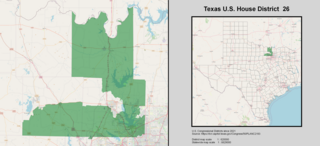
Texas' 26th congressional district of the United States House of Representatives includes rural Cooke County to the north and some of Wise County to the West and includes parts of Denton County, including Flower Mound, Lewisville and parts of Corinth, Carrollton, Little Elm and The Colony. The current Representative is Michael C. Burgess. The district is best known as the seat of former House Majority Leader Dick Armey.

Florida's 1st congressional district is a congressional district in the U.S. state of Florida, covering the state's western Panhandle. It includes all of Escambia, Okaloosa, Santa Rosa counties, and portions of Walton county. The district is anchored in Pensacola and also includes the large military bedroom communities and tourist destinations of Navarre and Fort Walton Beach and stretches along the Emerald Coast. The district is currently represented by Republican Matt Gaetz. With a Cook Partisan Voting Index rating of R+19, it is the most Republican district in Florida.

Kentucky's 3rd congressional district is a congressional district in the U.S. state of Kentucky. It encompasses almost all of Louisville Metro, which, since the merger of 2003, is consolidated with Jefferson County, though other incorporated cities exist within the county, such as Shively and St. Matthews. The far eastern portions of Louisville Metro are part of the 2nd congressional district.

Kentucky's 6th congressional district is a congressional district in the U.S. state of Kentucky. Based in Central Kentucky, the district contains the cities of Lexington, Richmond, and Georgetown. The district is currently represented by Republican Andy Barr.
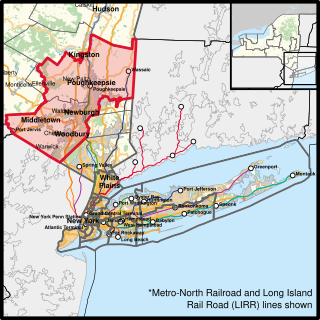
New York's 18th congressional district is a congressional district for the United States House of Representatives that contains the northern suburbs and exurbs of New York City. It is currently represented by Democrat Pat Ryan.

South Carolina's 3rd congressional district is a congressional district in western South Carolina bordering both Georgia and North Carolina. It includes all of Abbeville, Anderson, Edgefield, Greenwood, Laurens, McCormick, Oconee, Pickens, and Saluda counties and portions of Greenville and Newberry counties. The district is mostly rural, but much of the economy revolves around the manufacturing centers of Anderson and Greenwood. With a Cook Partisan Voting Index rating of R+21, it is the most Republican district in South Carolina.

The politics of Oklahoma exists in a framework of a presidential republic modeled after the United States. The governor of Oklahoma is both head of state and head of government, and of a pluriform two-party system. Executive power is exercised by the governor and the government. Legislative power is vested in the governor and the bicameral Oklahoma Legislature. Judicial power is vested in the judiciary of Oklahoma. The political system is laid out in the 1907 Oklahoma Constitution.

Florida's 2nd congressional district is a congressional district in the U.S. state of Florida. The district consists of the eastern part of the Florida Panhandle along with much of the Big Bend region along the Emerald Coast. It straddles both the Eastern and Central time zones. It is anchored in Tallahassee, the state capital, and includes Panama City. With 49% of its residents living in rural areas, it is the least urbanized district in the state, and voters are generally conservative. The district is represented by Republican Neal Dunn.

Oklahoma's 1st congressional district is in the northeastern corner of the state. Anchored by Tulsa, it is largely coextensive with the Tulsa metropolitan area. The district contains all of Tulsa County as well as portions of Creek, Rogers & Wagoner counties. Although it has long been reckoned as the Tulsa district, a small portion of Tulsa itself is located in the 3rd district.

Oklahoma's 2nd congressional district is one of five United States congressional districts in Oklahoma and covers approximately one-fourth of the state in the east. The district borders Arkansas, Kansas, Missouri, and Texas and includes a total of 24 counties. With a Cook Partisan Voting Index rating of R+29, it is the most Republican district in Oklahoma, a state with an all-Republican congressional delegation.
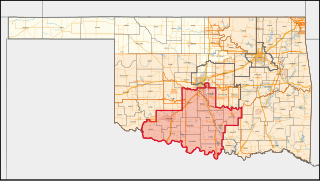
Oklahoma's 4th congressional district is located in south-central Oklahoma and covers a total of 15 counties. Its principal cities include Midwest City, Norman, Moore, Ada, Duncan, Lawton/Ft. Sill, and Ardmore. The district also includes much of southern Oklahoma City.

Oklahoma's 5th congressional district is a congressional district in the U.S. state of Oklahoma. It borders all of the other congressional districts in the state except the 1st district. It is densely populated and covers most of Oklahoma County and all of Lincoln, Pottawatomie and Seminole counties, as well as parts of Canadian and Logan counties. With a Cook Partisan Voting Index rating of R+12, it is the least Republican district in Oklahoma, a state with an all-Republican congressional delegation.
Missouri's 7th congressional district consists of Southwest Missouri. The district includes Springfield, the home of Missouri State University, the Joplin, Missouri, metropolitan area, Missouri's 5th largest, and the popular tourist destination city of Branson. Located along the borders of Kansas, Oklahoma, and Northwest Arkansas, the district occupies part of the Bible Belt with a strong socially conservative trend. George W. Bush defeated John Kerry here 67% to 32% in the 2004 election. Republican John McCain defeated Democrat Barack Obama 63.1% to 35.3% in the 2008 election. Republican and Former Massachusetts Governor Mitt Romney defeated Barack Obama 67.6% to 30.3% in the 2012 election. In the 2020 election, Republican Donald Trump defeated Democrat Joe Biden 69.91% to 28.93%. As of 2020, this district is the second most strongly Republican district in Missouri and is one of the most strongly Republican districts in the United States.

North Carolina's 5th congressional district covers the central western portion of North Carolina from the Appalachian Mountains to the western suburbs of the Piedmont Triad. The district borders Tennessee and Virginia, with the bulk of its territory in the mountains; it stretches just far enough to the east to grab its share of Forsyth County, home to most of its population.
Missouri's 4th congressional district comprises west-central Missouri. It stretches from the northern half of Columbia to the southern and eastern suburbs of Kansas City, including a sliver of Kansas City in Cass County and parts of Blue Springs in Jackson County. It also includes the northern portion of Columbia, home to the University of Missouri.







